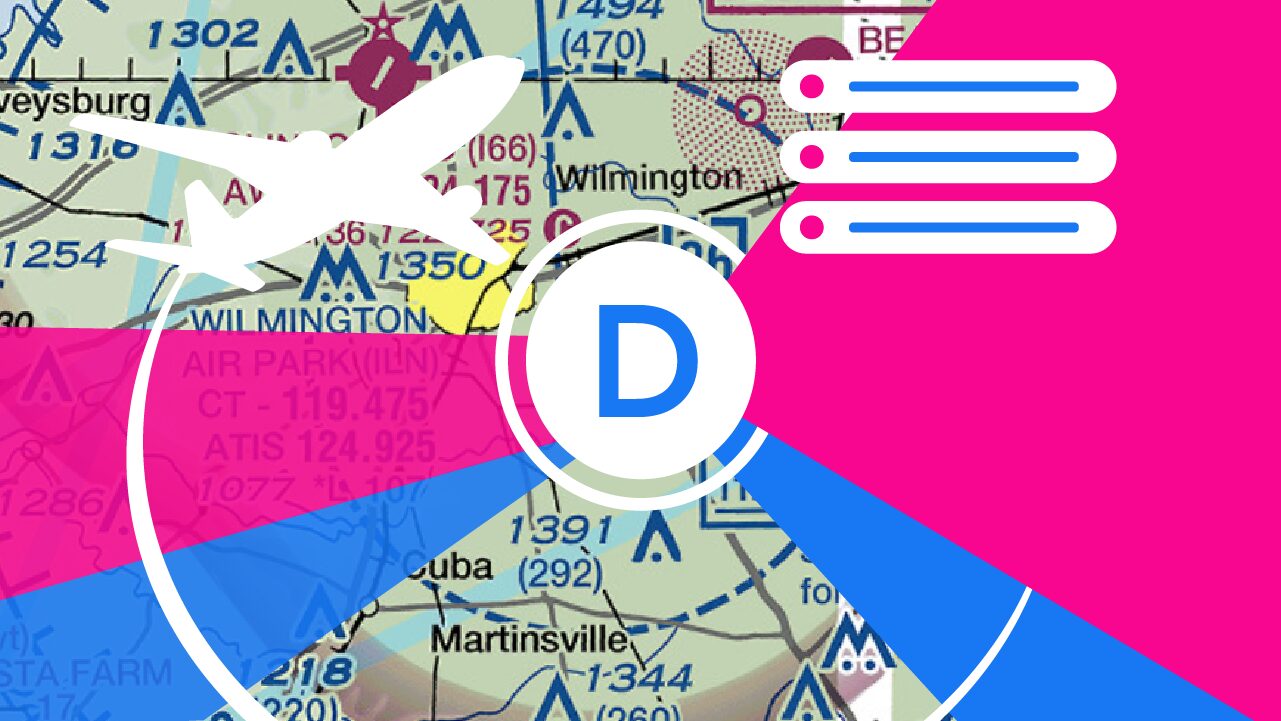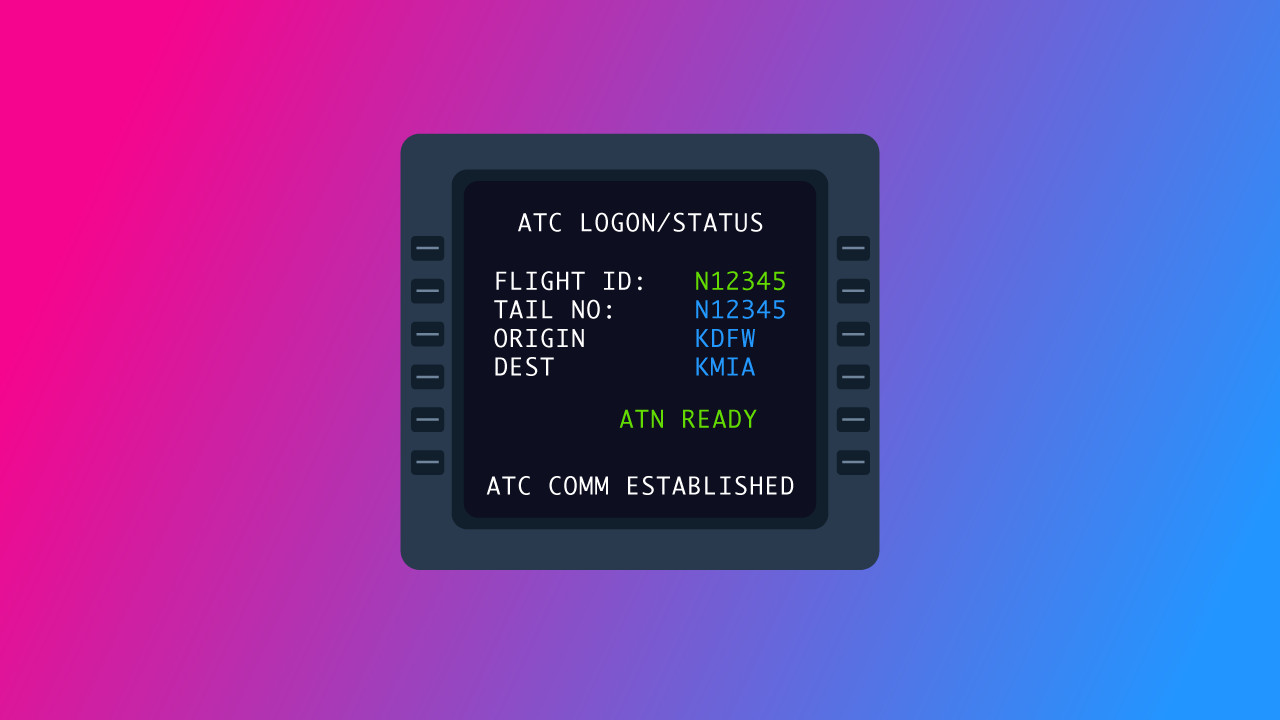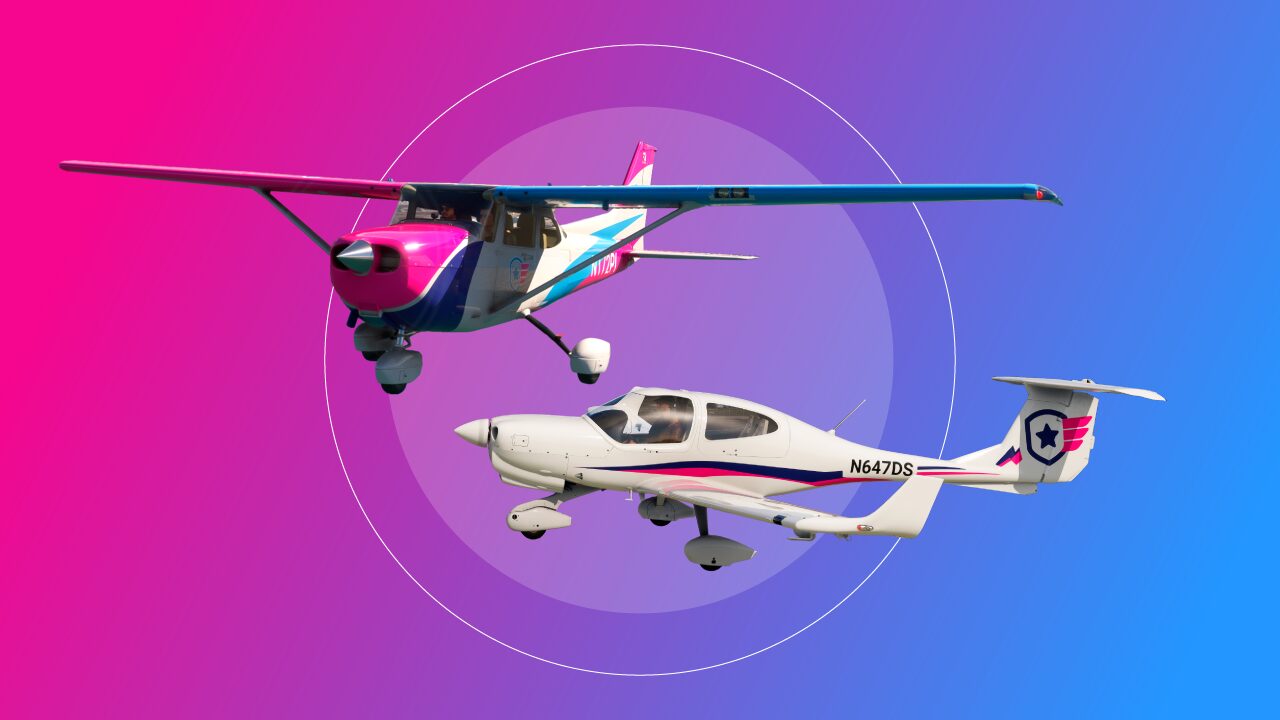-
Key Takeaways
-
What is Class D Airspace?
- Horizontal Boundary
- Vertical Limit
- Operational Hours
-
Operating Requirements in Class D Airspace
- Pilot and Equipment Requirements
- Weather Requirements
- How to Enter Class D Airspace
- How to Operate Inside Class D Airspace
-
Class D Airspace vs. Other Airspace Classes
- Class B
- Class C
- Class E
-
Conclusion
Worried about pilot deviations at towered airports?
We get it. Busy controlled airspace is intimidating, with fast-moving jets and rapid-fire radio communications. It’s easy to become overwhelmed.
The solution? Start small, and know what to expect before you call up ATC.
The smallest controlled airports are in Class D airspace, so why not begin there?
In this article, we’ll help you master Class D airspace.
Key Takeaways
- Class D airspace ensures organized traffic flow around small, towered airports.
- Requires an operating control tower, communications down to the runway, and weather observation capabilities.
- Marked on charts by a blue dashed line with a radius of around 4.5 nautical miles. Extends from the surface to around 2,500 feet AGL.
- Requires a two-way radio for entry, with pilots responsible for visibility and cloud clearance.
What is Class D Airspace?
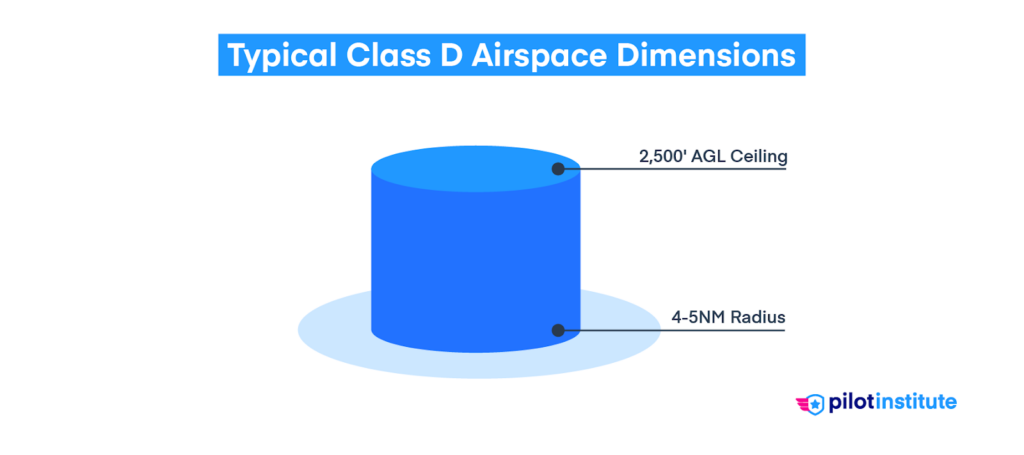
Class D or Delta airspace surrounds small, towered airports. It allows air traffic control (ATC) to provide a safe and organized traffic flow into and out of the airport.
You’ll find a diverse mix of air traffic at Class D airports. Most are general aviation aircraft, with light piston airplanes being the most popular.
Don’t assume this means Class D airports aren’t very busy. Many Class D airports are hubs for lively flight training operations. Air Taxis and jet charter operations are also fairly common.
You might also spot emergency services like medevac or search and rescue operations. Some airports even have military operations co-located with civilian aviation activities. Occasionally, you’ll find commercial airline service with regional or commuter aircraft.
There may be multiple airports within a single Class D airspace. The primary airport will be the one in the middle of the circle.
The primary airport for Class D airspace must have:
- An operating air traffic control tower.
- Communications capability down to the runway surface.
- Operational weather observations.
Horizontal Boundary
Sectional charts mark Class D airspace with a blue dashed line. You’ll see it depicted as a circle surrounding a towered airport.
The circle usually has a radius of around 4 to 5 nautical miles (nm), although it can vary depending on the location. You can find Class D airspace with a radius of as low as 2.5nm or as large as 7nm!
Often, the airspace does not form a perfect circle. You’ll see some sections cut out or awkward shapes added in.
The airspace uses cutouts or shelves to exclude satellite airports without an operating control tower.
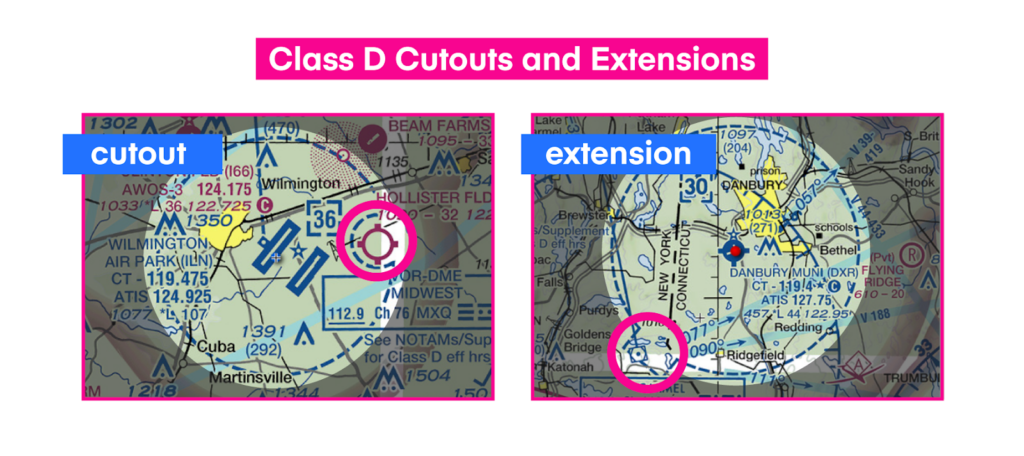
Sometimes, the airspace boundary juts out a bit. This is an airspace extension. Extensions protect instrument flight rules (IFR) aircraft during arrivals and departures.
Vertical Limit
Class D airspace generally extends from the surface up to 2,500 feet above ground level (AGL). That’s height, not altitude.
So, for example, if a Class D airport’s elevation is 1,000 feet above mean sea level (MSL), its airspace typically extends to 3,500 feet MSL.
Airspace ceilings are published as MSL altitudes and rounded to the nearest 100 feet. So, you don’t need to do any calculations – simply read it off the chart.
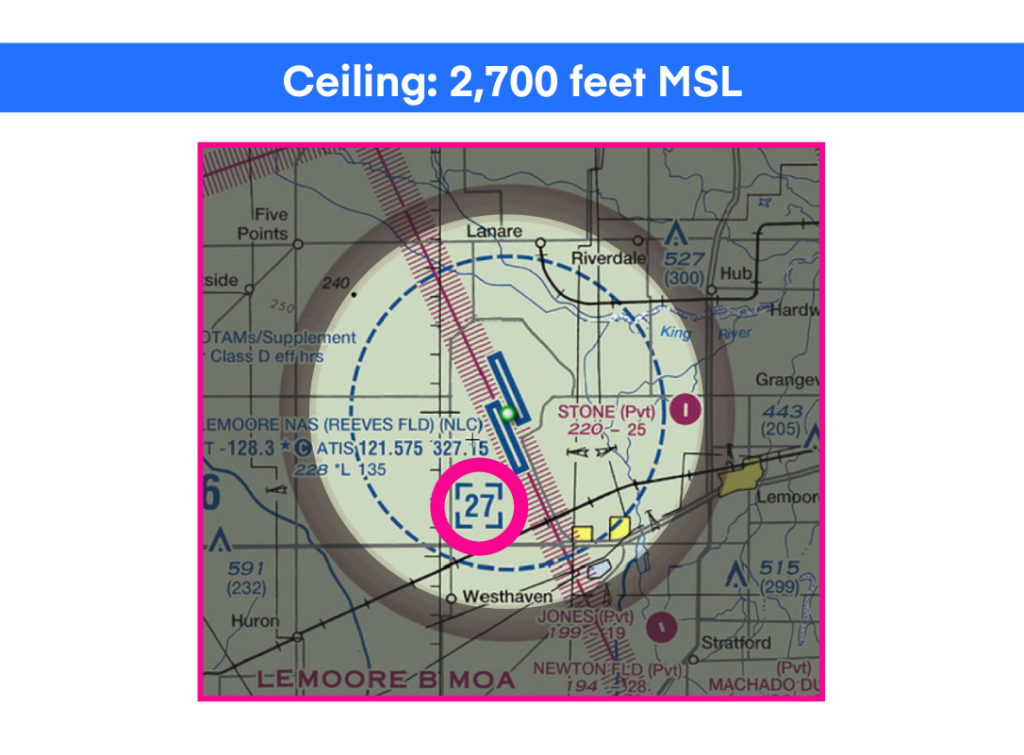
The chart shows the altitude in blue, surrounded by a box with dashed lines. In the example image, the Class D ceiling for Reeves Field is written as 27, which means 2,700 feet MSL.
Occasionally, you may see a minus sign preceding the number. The minus sign means that the airspace extends up to but does not include the altitude shown.
Why would an airspace stop short of the ceiling?
Sometimes, a smaller airport’s Class D airspace sits under a major airport’s Class C or Class B airspace.
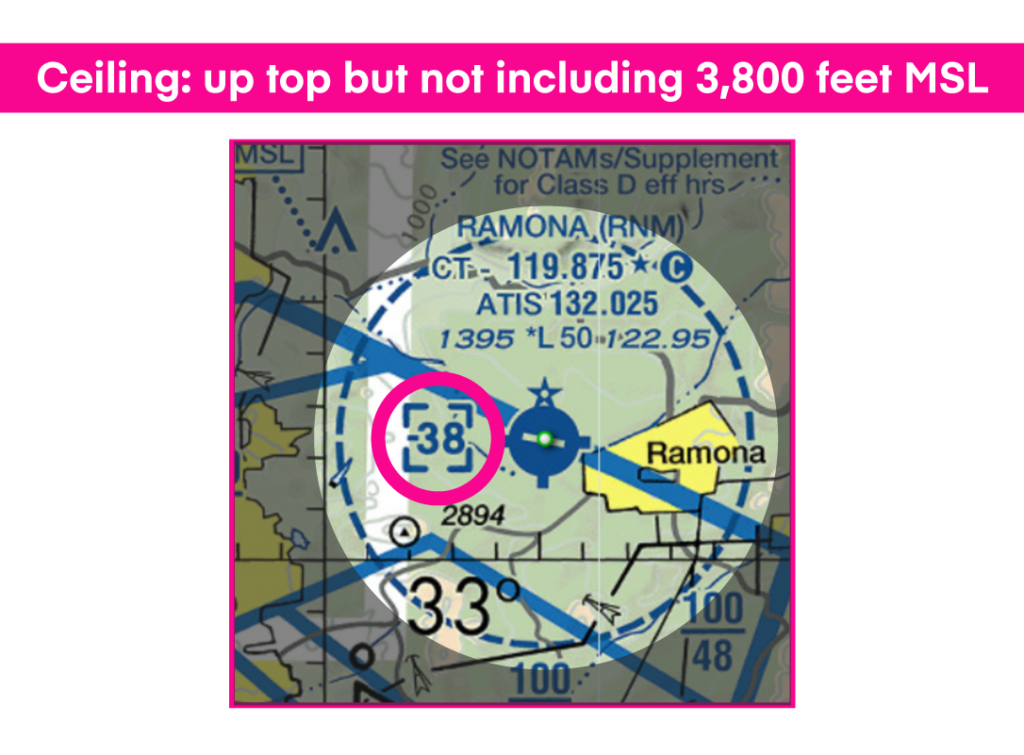
Of course, you can only be in one class of airspace at a time. So, the Class D airspace gets trimmed at 3,799 feet MSL, and the higher class starts at 3,800 feet.
Occasionally, Class D airspace is partially (but not entirely) overlapped by another airspace. In this case, the airspace with more restrictive rules takes priority.
For example, look at the areas around Boeing Field. Its Class D airspace is covered by Sea-Tac’s Class B airspace. The Class D has a ceiling of 2,500 feet. But you’ll have to follow Seattle’s Class B rules if you’re above 1,800 feet near the stadiums or above 2,000 feet around the I-90 bridge.
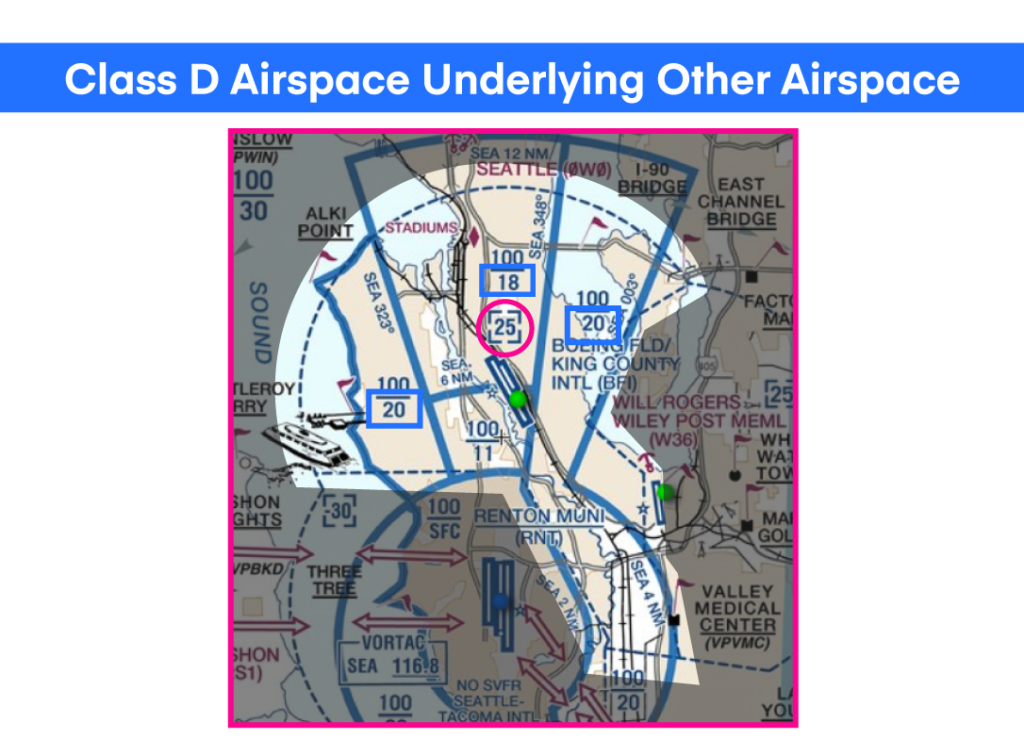
In practice, controllers coordinate with each other when aircraft move across airspace boundaries. They could hand you off before you enter the boundary or stay with you for some time if you need radar navigation.
However, you do need to ensure you meet the requirements for any airspace you enter.
Operational Hours
Some control towers only operate part-time. You’ll encounter this at smaller airfields where traffic slows during off-peak hours. These closures generally happen at night.
How would you know if a tower only operates part-time? Look for a small blue star next to the tower’s frequency on the chart.
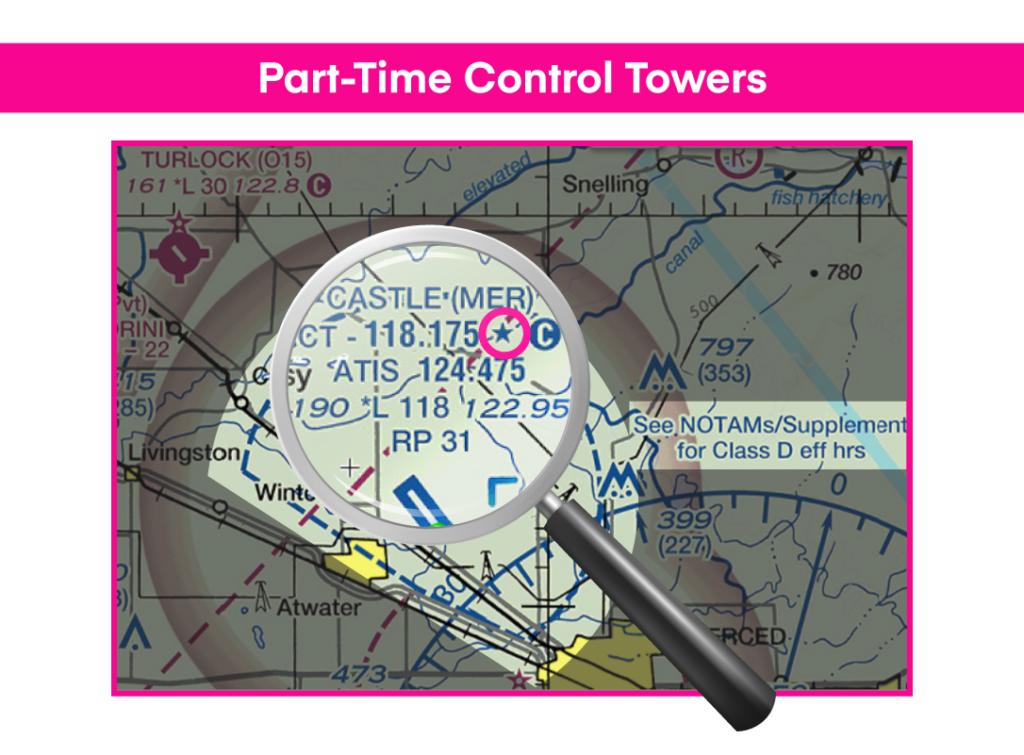
To find out the tower’s operating hours, search for the airport in the Chart Supplement. The airport will issue a NOTAM if the tower is only temporarily inactive.
What happens to the surrounding airspace when the tower’s closed?
The Class D airspace becomes either Class E or G airspace. The Chart Supplement indicates which airspace class comes into effect.
For Class E designation, the airport must meet two requirements. First, aircraft must be able to maintain radio contact with ATC down to the surface. Second, the airport must meet specific weather reporting requirements.
The airport’s airspace becomes Class G if it can’t meet those requirements.
As with a traditional non-towered airport, pilots self-announce and coordinate with each other. Pilot-to-pilot communication happens on the Common Traffic Advisory Frequency (CTAF). An airport’s CTAF is typically the same as the tower’s frequency.
Operating Requirements in Class D Airspace
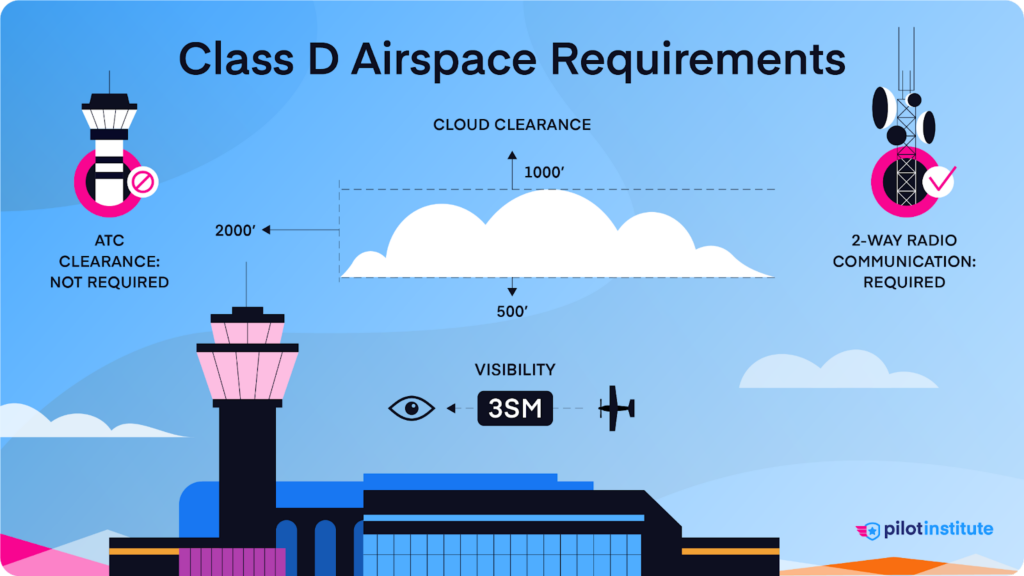
Flight rules within Class D are more structured and formal than in Classes E and G.
Since the airspace can get busy, the requirements are also stricter.
Pilot and Equipment Requirements
Class D airspace is relatively forgiving compared to other towered airport airspace. There’s no specific pilot certification required. The only equipment you’ll need is a two-way radio. You don’t even need a transponder!
Weather Requirements
If flying under visual flight rules (VFR), you must ensure the weather conditions meet the FAA’s basic VFR minimums.
- Flight visibility must be at least three statute miles.
- The ceiling must be at least 1,000 feet.
- You must maintain a cloud clearance of at least 500 feet below, 1,000 feet above, and 2,000 feet horizontally.
Class D airspace goes down to the surface, so you can request a Special VFR (SVFR) clearance if the weather conditions are marginal. What are the SVFR requirements? Learn more about special VFR clearances in this article.
How to Enter Class D Airspace
Class D airspace doesn’t require an ATC clearance to enter. However, you must establish two-way radio communication with ATC before crossing the boundary.
What’s the difference?
You can’t enter the airspace at busy Class B airports until the controller gives you a clearance. In Class D, however, you can enter even if the controller responds with “[Your callsign], standby.”
An acknowledgment of your callsign meets the two-way radio requirements. Crucially, if ATC doesn’t mention your callsign, it does not count as two-way communication. You can’t enter the airspace until the controller is free to talk to you.
ATC may also prohibit entry into Class D if the traffic level or ATC workload is too high. In this case, you’ll have to wait outside the airspace until the controller allows you in.
How to Operate Inside Class D Airspace
If you depart from a towered airport inside Class D airspace, you will already be in two-way radio contact. Maintain contact with ATC until they instruct you to switch over.
If departing from a non-towered satellite airport within Class D, contact the primary airport’s ATC facility immediately after takeoff.
After takeoff, keep an eye on your airspeed if you’re flying something fast. Class D airspace has a speed limit of 200 knots for aircraft within 4nm of the primary airport. ATC can override this if necessary.
ATC is not required to provide separation services for VFR aircraft. Although they will sequence departures and arrivals, VFR pilots are responsible for separation.
ATC provides separation between IFR-IFR and IFR-SVFR aircraft in Class D airspace. If they’re not too busy, they will also offer traffic and safety alerts to VFR aircraft.
Class D Airspace vs. Other Airspace Classes
Now that you know all about Class D operations, see how they compare with other controlled airspace classes.
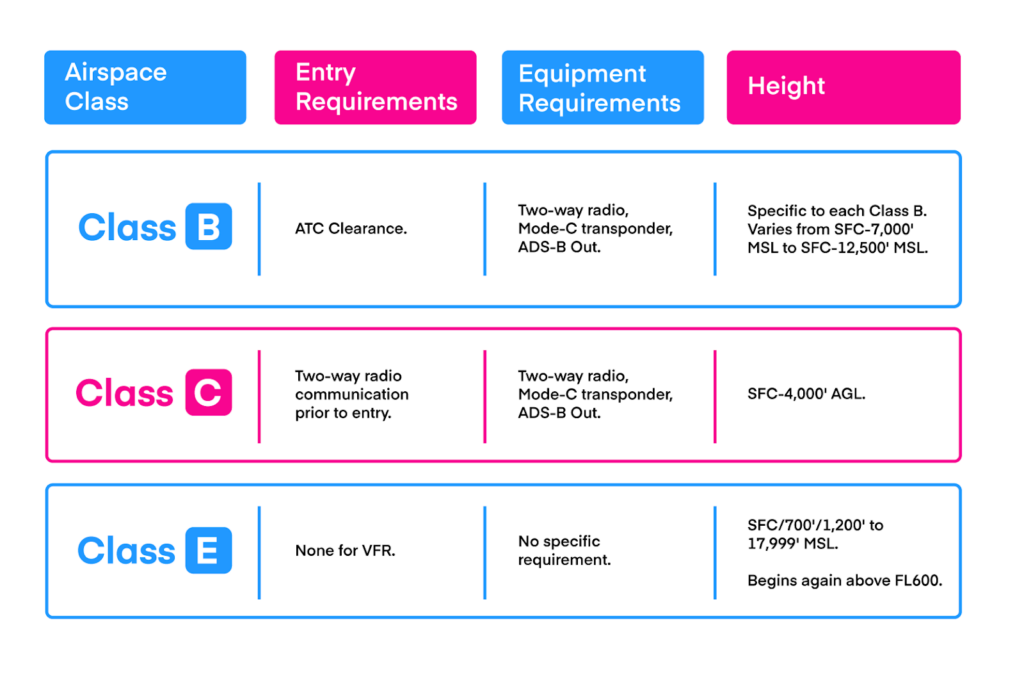
Class B
Class B, or Bravo, airspace surrounds the busiest airports in the US. Consequently, you need to be careful not to breach the airspace without permission. Unlike in Class D, you need explicit ATC clearance to enter Bravo airspace.
Your aircraft will need a Mode-C transponder with ADS-B Out and two-way radio. Pilots need at least a private pilot license to land at one of the primary airports inside Class B airspace. Student, sport, and recreational pilots cannot enter Class B airspace without specific training.
ATC offers separation between all aircraft operating in Class B.
If you’re flying VFR, you must remain clear of clouds. There are no minimum cloud distances.
The speed limit is 250 knots inside the Class B airspace. Underneath the Class B and inside VFR corridors, the speed limit is 200 knots.
Class C
Class C airspace drops the private pilot requirement of Class B airspace. However, the aircraft equipment requirements remain unchanged.
The entry procedure is similar to Class D: you just need to establish two-way radio comms.
The difference lies in how far from the airport you must first contact ATC. Class C airspace has an outer area around 20nm from the primary airport that acts as a buffer. ATC manages entry into Class C in this area and ensures an orderly flow through the boundary.
Class C controllers provide IFR-IFR and IFR-VFR separation. However, VFR aircraft must look out for other traffic.
VFR aircraft need to maintain the same cloud clearances as with Class D airspace. This requirement is due to the same lack of VFR separation offered by ATC.
If you’re within 4nm of the airport and at or below 2,500 feet AGL, you can’t fly faster than 200 knots. Think of it like a “Class D-sized” speed limit zone inside the airspace. Outside of this area, the limit is 250 knots.
Class E
Most of the controlled airspace in the National Airspace System is Class E.
You’ll often find Class E airspace surrounding non-towered airports. It enables ATC to provide IFR aircraft with services like traffic separation. ATC can only separate IFR aircraft from other IFR aircraft, though.
In Class D airspace, ATC is in contact with all aircraft -VFR and IFR – and knows where each aircraft is. This awareness allows them to offer pilots accurate traffic information.
However, in Class E airspace, VFR aircraft don’t need a transponder or a radio. Aircraft without this equipment are invisible to ATC.
The FAA’s ADS-B mandate excludes Class E airspace under 2,500 feet AGL. So, don’t assume there’s no traffic just because your ADS-B In display shows an empty sky. Visually scanning for traffic is the only way to ensure safe separation in Class E airspace.
Be sure to brush up on your non-towered airfield traffic pattern!
Conclusion
Class D airspace offers all the benefits of ATC without the complex rules of bigger airports.
If you’re exploring towered airports for the first time, Class D airports are a great place to start.
Want to learn more about airspace? Find out how other classes work in this comprehensive guide to airspace.
